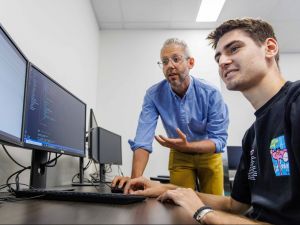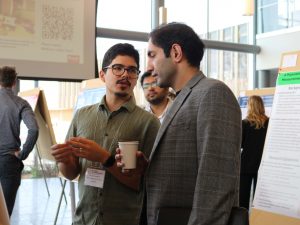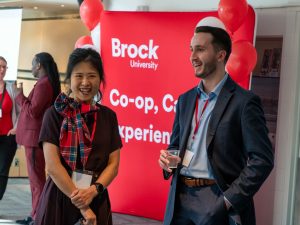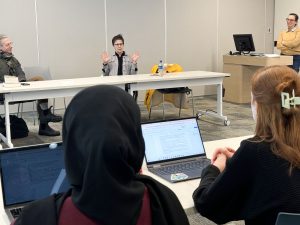Being a varsity athlete can take up a lot of time. Brock’s student athletes must maintain good academic standing with a full-time course load and also dedicate an average of 15 hours per week to training and competition.
So, between studying, training, practising and competing, where do they find the time to participate in Impact (Intensive Measures Police And Community Together), Brock’s community outreach program where student athletes act as mentors to at-risk high school students?
Stefanie Pavlovich (BEd ’10, BPhEd ’10), the program’s 2009-10 coordinator and member of Brock’s Women’s Rugby team, explains that it’s not necessarily about having the time, it’s about making the time for an important initiative. As an aspiring teacher, Pavlovich feels that participating in the program not only helps at-risk students, but prepares her for her career ahead.
“I wanted the opportunity to mentor students in the right direction,” said Pavlovich. “I recognize and understand the importance of developing a positive experience for a high school student. Too many students today are at risk, and I really wanted to connect with at least one student to create that positive experience.”
At-risk learners typically experience increased school drop-out rates as a result of poor discipline or behaviour, lack of school attendance, social and emotional issues, family problems, academic and educational issues, a lower socioeconomic status, mental or physical health concerns, or substance abuse.
Recognizing this need, Brock’s Impact program was first implemented at Port Colborne High School in the spring of 2004 in partnership with the Niagara Regional Police Service and under the leadership of Tracy Sacco (BEd ’85, MEd ’04), a District School Board of Niagara secondary school principal.
Impact was developed as a semi-structured, frequently occurring, one-on-one mentorship program for at-risk youths with the goal of influencing them to maintain good health, develop communication and interpersonal skills, create respectful relationships, form aspirations to stay in school and learn to support themselves afterwards. It was the hope of all parties involved in the program that by providing this service to youth, their perceptions would change, resulting in a change of the behaviours that label then as at risk.
In addition to traditional mentors such as teachers and police officers, the program needed non-traditional mentors the kids could look up to and relate to. As natural leaders and positive role models, Brock University athletes were chosen.
Youth are paired one-on-one with a Brock athlete mentor and meet every second Tuesday evening at St. Catharines Collegiate. The youth-mentees interact with the athlete-mentors within a positive learning environment and participate in social and recreational activities, including games that challenge both the mind and the body.
Guest speakers interact with the youth and their mentors, discussing topics such as anger management, drug use, healthy sexuality and athletics and team play. Workshops are held to develop life skills and involve resume skill building, improving interview skills and creating personality profiles.
Once in a while the youth are treated to a night away for bowling and dinner or for basketball at Brock’s large, varsity gyms.
Currently in its sixth year, Brock’s Impact program has experienced a dramatic increase in the number of youth and mentors involved since its inaugural year. In 2004, the program involved eight mentors and a similar number of youth-mentees. Now the program attracts more than 50 mentors and 50 youth every year.
One of the greatest benefits of the Impact program is the relationships that are formed, both between athlete-mentor and youth-mentee and between the athletes themselves.
“This program is beneficial for both youth and athlete,” comments Pavlovich. “Each gains a better understanding of the importance of setting goals and aspirations while having fun at the same time. This is an opportunity for both parties involved to learn a different perspective and have an impact on one another.”
Joey Pell, a fourth-year geography major and Brock varsity hockey player, has been involved with Impact since his first year. He believes the program is important because it provides youth with a safe place to go and it gives them something to look forward to.
“The Impact program really got to me during my first year,” explains Pell. “My mentee was running late one night and when he walked into the gym, I could tell he was trying his hardest to find me. When he did, he had the biggest smile on his face. That’s when I knew that I actually meant something to him and that that he looked forward to seeing me.”
James Fielding (BKin ’06, MEd ’09), one of Impact’s inaugural athlete-mentors, investigated the effects of the program for his master’s thesis Making an IMPACT: The Effect of a Community Based Mentor Program on the Lived Experience of the Youth Involved. In his thesis, he explains that “after nearly three years of research, data collection, analysis and writing, it is clear to me, now more than ever, that programs such as Impact are not only beneficial but necessary if we are to tap into the hidden potential of all youth”.
He also wrote that although a small number of mentees were not positively affected by the program, most of the participants were grateful and said it changed their views.
Todd Erskine (BA ’99), Brock’s Women’s Hockey coach, has been part of the Impact program since its inception and has seen the positive effect on Brock’s athletes. “Athletes find the experience very rewarding. Not only do they feel that they are impacting a student who may need a little extra guidance, but they like interacting with other athletes outside of their element — a brotherhood/sisterhood develops outside of their normal sport or classroom setting”.
The relationships that are formed between youth and athlete often continue to develop even after the program is over. Many keep in touch via email and Facebook. Erskine said that one student invited her athlete-mentor to her wedding. “It just goes to show you how important this program is,” said Erskine. “We’re having a greater impact on these students than we ever thought we would.”










Can we still refer students to your program. If so what is the process?
Thanks Sue
School Nurse